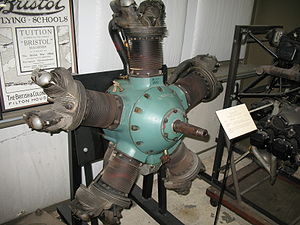avia.wikisort.org - Engine
The Kinner B-5 was a popular five cylinder American radial engine for light general and sport aircraft of the 1930s.
| B-5 | |
|---|---|
 | |
| A Kinner B-5 on display at the Old Rhinebeck Aerodrome in New York, as used in their Fleet Finch biplane. | |
| Type | Radial engine |
| Manufacturer | Kinner Airplane & Motor Corporation |
| Developed from | Kinner K-5 |
| Developed into | Kinner R-5 |
Design and development
The B-5 was a development of the earlier K-5 with slightly greater power and dimensions. The main change was the increase in cylinder bore from 108 mm (4.25 in) to 117 mm (4.625 in) and a corresponding increase in displacement from 372 cu in (6.1 liters ) to 441 cu in (7.2 liters ). One difference the B-5 had from radial engines of other manufacturers was that each individual cylinder had its own camshaft, a system also used by the contemporary Soviet-built, 8.6 litre-displacement Shvetsov M-11 five cylinder radial, while most other radial engine designs used a "cam ring" for the same purpose, connected to every cylinder's valves. The B-5 was a rough running but reliable engine. The B-5 and its derivatives were produced in the thousands, powering many World War II trainer aircraft; its military designation was R-440. The B-5 was followed by the R-5 and R-55.
Applications
- Fleet Fawn
- Fleet Finch
- Kinner Sportster
- Kinner Sportwing
- Lincoln AP
- Monocoupe 125
- Redfern DH-2
- Ryan PT-22 Recruit
- Savoia-Marchetti S.56
Specifications (Kinner B-5)
Data from Jane's all the World's Aircraft 1938[1]
General characteristics
- Type: Five-cylinder, air-cooled, radial
- Bore: 4.625 in (117.5 mm)
- Stroke: 5.25 in (133 mm)
- Displacement: 441 cu in (7.23 l)
- Length: 32.325 in (821.1 mm)
- Diameter: 45.375 in (1,152.5 mm)
- Dry weight: 295 lb (134 kg)
Components
- Valvetrain: 1 Inlet and 1 Exhaust valve per cylinder, individual camshafts for each cylinder
- Fuel system: 1x Holley or Stromberg Carburetor
- Fuel type: 73 Octane
- Oil system: Circulating dry sump system
- Cooling system: Air-cooled
Performance
- Power output: 125 hp (93 kW) at 1,925 rpm max; 89 hp (66 kW) at 1,725 rpm cruise
- Compression ratio: 5.25:1
- Specific fuel consumption: 0.60 lb/hp hr (0.365 kg/kw hr)
- Oil consumption: 0.025 lb/hp hr (0.0152 kg/kw hr)
- Power-to-weight ratio: 0.42 hp/lb at cruise
See also
Related development
Comparable engines
Related lists
References
| Wikimedia Commons has media related to Kinner B-5. |
- Grey, C.G.; Bridgman, Leonard, eds. (1938). Jane's all the World's Aircraft 1938. London: Sampson Low, Marston & company, ltd. p. 88d.
Further reading
- Gunston, Bill (1986). World Encyclopedia of Aero Engines. Newton Abbot: Patrick Stephens. pp. 99–100.
External links
На других языках
[de] Kinner B-5
Der Kinner B-5 war in den 1930er Jahren ein verbreiteter US-amerikanischer Fünfzylindersternmotor für die Allgemeine Luftfahrt.- [en] Kinner B-5
[fr] Kinner B-5
Le Kinner B-5 était un moteur cinq cylindres en étoile américain pour avions légers et avions de sport des années 1930.Другой контент может иметь иную лицензию. Перед использованием материалов сайта WikiSort.org внимательно изучите правила лицензирования конкретных элементов наполнения сайта.
WikiSort.org - проект по пересортировке и дополнению контента Википедии